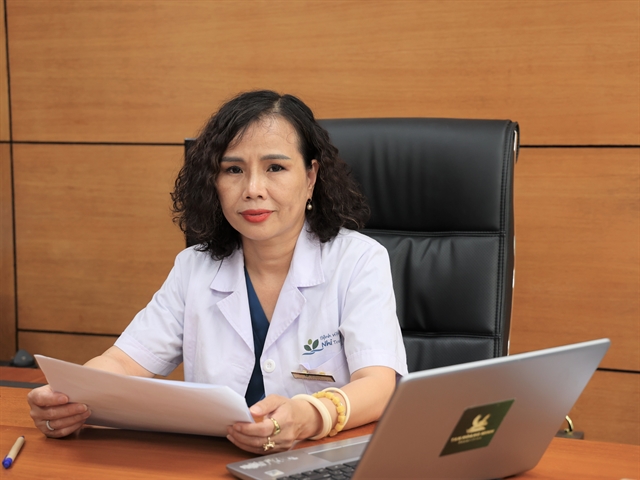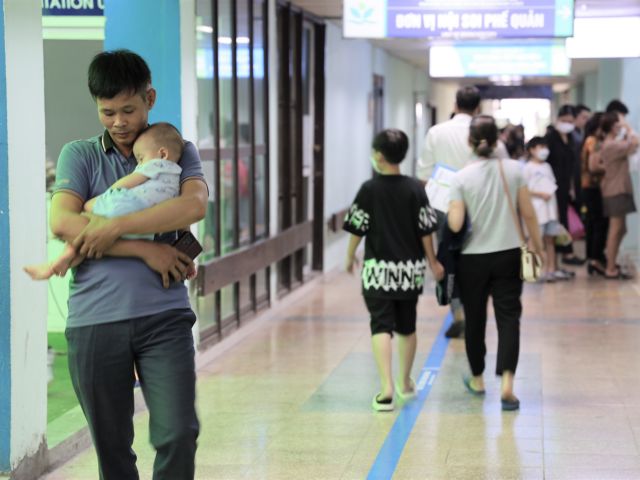 Society
Society


|
| Associate Professor Dr Trần Thanh Tú, Director of International Centre, Vietnam National Children’s Hospital. — VNS Photo Vân Nguyễn |
In a recent interview with Việt Nam News reporter Vân Nguyễn, Associate Professor Dr Trần Thanh Tú, Director of International Centre, Vietnam National Children’s Hospital, talks about the changes in the epidemiology of acute respiratory infections post-COVID-19 and the treatment regimes in use for the disease.
Could you tell us about respiratory diseases during the summer season?
Vietnam National Children’s Hospital is a general hospital for children but there are many specialised departments. Here at the International Centre, people often come for acute diseases. Respiratory tract infections, especially upper respiratory tract infections, account for 60-70 per cent of all acute diseases treated here.
A child, especially those under two, will acquire respiratory infections, mostly upper respiratory tract infections, three to five times a year. This is observed not only at the Vietnam National Children’s Hospital but other health establishments.
In some cases, the conditions of patients will progress into more severe diseases including bronchitis, pneumonia and bronchiolitis.
When is the high season for respiratory diseases?
Respiratory tract infections happen all year round at different scales, especially after COVID-19, the epidemiology of acute respiratory infection has changed a lot.
For example, following a COVID-19 outbreak in April-May 2022, there was a serious Adenovirus breakout. Before the pandemic, Adenovirus tended to appear in autumn-winter time yet last year it occurred in summer.
There were diseases that used to occur only in certain periods of the year. RSV virus developed mostly in September and October and flu often in December and January. However, things seemed to turn upside down following COVID-19. We saw Adenovirus and flu in the summer. And this year, there have been mycoplasma pneumoniae outbreaks (Mycoplasma pneumoniae is a common cause of acute respiratory tract infections, especially in school-age children) since Lunar New Year (which fell in February), in many hospitals.
At the Vietnam National Children’s Hospital, the number of patients acquiring mycoplasma pneumoniae infection has surged. This is a problem that we are facing.

|
| A baby in his dad's arm at the Vietnam National Children’s Hospital's Unit of Bronchoscopy. — VNS Photo Vân Nguyễn |
So what is the treatment regime for respiratory infections?
The treatment regime depends on the causes of the disease. For most respiratory infection cases, especially upper respiratory tract infections, the cause is viruses.
One of them is the RSV virus, which can cause common illnesses in children, especially bronchiolitis.
With young children, bronchiolitis will have a more intense clinical manifestation, including difficulty breathing, wheezing and even respiratory failure.
These are also signs that parents would be worried about. These are severe cases, and in general, respiratory infections caused by RSV or influenza are usually treated at home, but in cases of complications or when respiratory infections occur with other infections, the conditions of the patient will get worse and they have to be hospitalised. In this case, antibiotics will be used.

|
| Parents and children at the hospital where respiratory tract infections, especially upper respiratory tract infections, account for 60-70 per cent of all acute diseases treated here. — VNS Photo Vân Nguyễn |
As for the common viral infections, they will mainly be symptomatic treatments, and superinfection treatments if any.
When it comes to RSV, it should be noted that it increases secretion a lot and causes wheezing, often making the family extremely worried.
The increase in secretions and wheezing will create conditions for bacteria to develop and it will cause superinfection and make the baby's condition worse.
For cases of the flu, we generally use Tamiflu, a special drug for influenza A.
Flu used to occur only around December and January. However, last year we saw that the flu appeared in June and July, it was the complete opposite of all the other cases and this year we saw small outbreaks of flu before April.
For influenza B, the treatment regime will focus on superinfection treatment.
One of the risks of influenza B is that there is very high rate of bacterial co-infection and it will cause pneumonia caused by bacteria, in those cases we have to use antibiotics.
As for viruses like RSV that cause bronchitis, one of the recommendations is that we focus on symptomatic treatment to reduce symptoms including spasms and reduce bleeding. We only use it in case of patients with superinfection. — VNS




